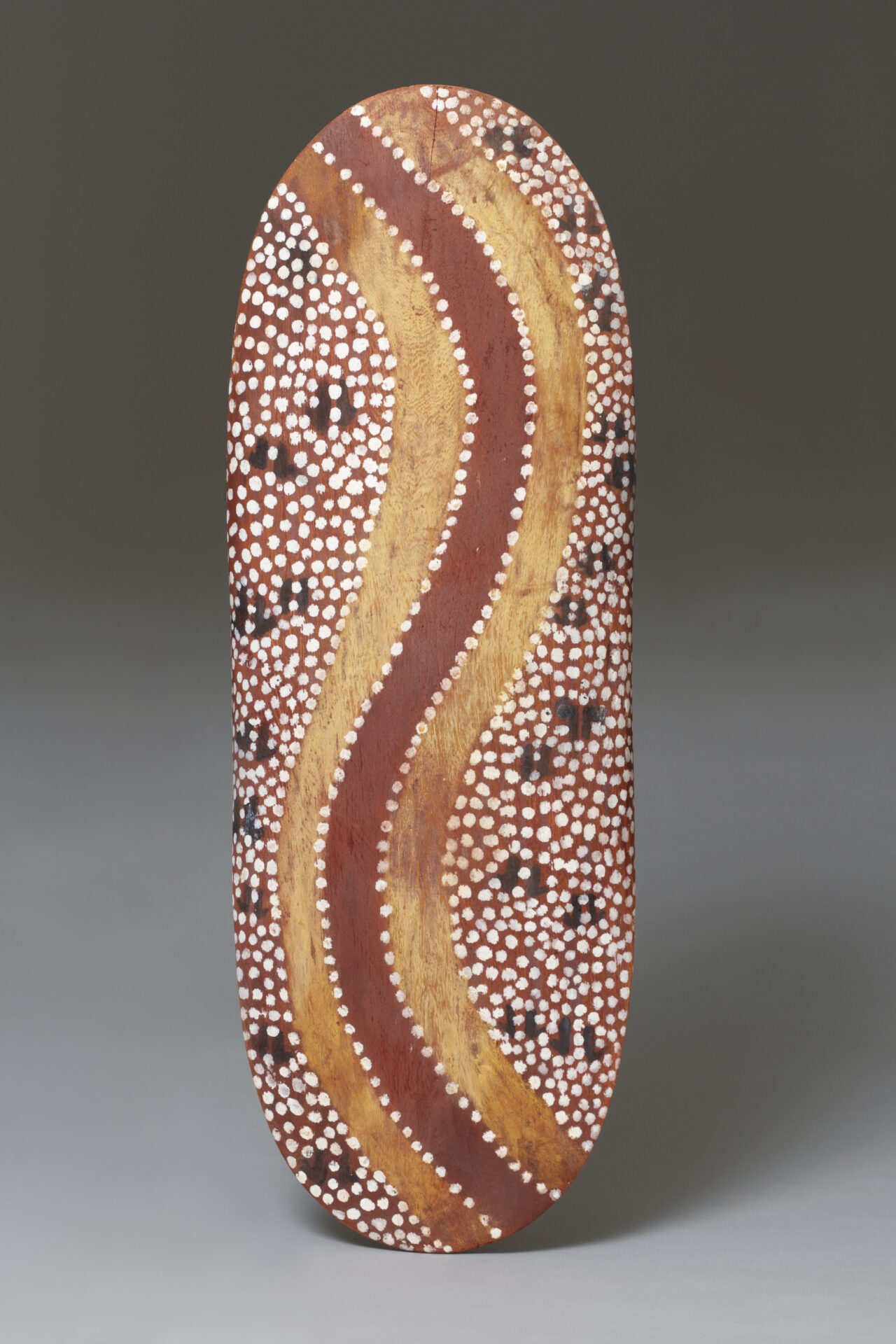
Article by Dr Debbie Argue
Visiting Fellow,
School of Archaeology and Anthropology, ANU
The image you see here is a 3D print of a skull called Liang Bua I or LB1. It represents the only skull known of a new species called Homo floresiensis.
Homo floresiensis was a surprise discovery in 2003 by an Australian-Indonesian archaeological team who were trying to find the origins of the first Australians. Their focus was Liang Bua cave, on the island of Flores, Indonesia. But it was not modern human bones that they found. The archaeologists discovered something completely unprecedented. Deep in the excavation were bones representing a number of very small individuals dated to between 95,000 and 52,000 years ago. These bones are quite different to anything yet known and the discoverers declared them to be a new species, Homo floresiensis.
Eighteen years on, and we know a lot about H. floresiensis. Individuals were short – about one metre tall. The one skull we have of this species had a small brain of only 426 cm3 (ours average 1300-1500 cm3); a backward sloping forehead, yet the brain possessed an expanded frontal cortex, or front part of the brain. This implies they could do some smart things such as plan, learn from mistakes, understand consequences of behaviour and moderate social behaviour. Stone tool-making is also attributed to H. floresiensis: stone tools were found in the excavations at Liang Bua.
This species walked upright. Its walk, however, would have been somewhat odd because its feet were quite long compared to its legs. It had to lift its feet up higher than we do, to get ground clearance. They lacked a chin, and instead had some ape-like structures inside the jaw. Wrist bones were also ape-like. The upper legs were relatively short, making the arms appear long. Its shoulders were shrugged and hunched forward.
The immediate and unresolved question is where does this species fit on the human evolutionary tree? Two ideas were originally proposed and are still being considered:
One is that H. floresiensis was the dwarfed descendant of a Homo erectus population that evolved under conditions of isolation on a small island (the “island rule”).
The “island rule” stipulates that body size of mammals alters when a founder population reaches a small island, becomes reproductively separated from its mainland origin group and faces an environment different from that of its mainland cousins. For example, a smaller body size could be expected as an evolutionary response to a limited food supply, and conversely a larger body size may occur in the absence of predation. Homo erectus lived on Java around one and a half million years ago. It had a much larger brain than H. floresiensis and its upper legs are similar to ours, so it would have been considerably taller than H. floresiensis. There is no evidence for H. erectus on Flores, but then, Flores is relatively unknown archaeologically.
The alternative idea is that H. floresiensis derived from an early lineage of Homo, similar to species that are known from around two million years ago in Africa, which were all relatively short. This would imply that an unknown founder population of archaic hominins arrived on Flores.
In 2016 archaeologists working at the site of Mate Menge, about seventy-four kms from Liang Bua cave, discovered a H. floresiensis-like, but considerably smaller, partial jaw of an adult individual, and some teeth. These are dated to 700,000 years ago and might well represent H. floresiensis’ ancestors, but we must await new discoveries of this group before we can be certain.
We do not know when H. floresiensis ancestors arrived on Flores. Nor do we know when the species became extinct. Even though the latest dates for the H. floresiensis bones is 52,000 years ago, it does not mean that the particular individual was the last one standing. Who knows what other evidence for the species is lying in wait for archaeologists to discover in this cave-rich island?
Another mystery is how H. floresiensis ancestors got to Flores, an island that has never been attached to a mainland, or indeed any other island. Did they float there accidently, perhaps as a result of a tsunami? Did they make watercraft? Did they swim? H. floresiensis is a remarkable discovery that continues tocapture our attention – it requires us to rethink so much that we thought we knew about human evolution.
Further reading
Argue, D, Donlon, D, Groves, C, & Wright, R 2006, ‘Homo floresiensis: Microcephalic, pygmoid, Australopithecus or Homo?’, Journal of Human Evolution, vol. 51, pp. 360-374.
Argue, D, Groves, CP, Lee, MSY, & Jungers, WL 2017, ‘The affinities of Homo floresiensis based on phylogenetic analyses of cranial, dental, and postcranial characters’, Journal of Human Evolution, vol. 107, pp. 107-133.
Brown, P, Sutikna, T, Morwood, MJ, Soejono, RP, Jatmiko, Saptomo, EW, & Awe, RD 2004, ‘A new small-bodied hominin from the Late Pleistocene of Flores, Indonesia’, Nature, vol. 431, pp. 1055-1061.
Jungers, W & Baab, K 2009, ‘The geometry of hobbits: Homo floresiensis and human evolution. Significance’, Significance, vol. 6, pp. 159-164.
Kaifu, Y, Baba, H, Sutikna, T, Morwood, MJ, Kubo, D, Saptomo, EW, Jatmiko, Awe, RD & Djubiantono, T 2011, ‘Craniofacial morphology of Homo floresiensis: Description, taxonomic affinities, and evolutionary implication’, Journal of Human Evolution, vol. 61, pp. 664-682.
Kaifu, Y, Kono, RT, Sutikna, T, Saptomo, WE & Awe, RD 2015, ‘Unique dental morphology of Homo floresiensis and its evolutionary implications’, PLoS One, vol. 10, no. 11, e0141614.
Larson, SG, Jungers, WL, Morwood, MJ, Sutikna, T, Saptomo, EW, Awe, RD & Djubiantono, T 2007, ‘Homo floresiensis and the evolution of the hominin shoulder’ Journal of Human Evolution, vol. 53, pp. 718-731.
Morwood, MJ & Jungers, WL 2009, ‘Conclusions: implications of the Liang Bua excavations for hominin evolution and biogeography’, Journal of Human Evolution, vol. 57, no. 5, pp. 640-648.
Morwood, MJ, Brown, P, Jatmiko, Sutikna, T, Saptomo, EW, Westaway, KE, Awe, RD, Roberts, RG, Maeda, T, Wasisto, S, & Djubiantono, T 2005, ‘Further evidence for small-bodied hominins from the late Pleistocene of Flores, Indonesia’, Nature, vol. 437, pp. 1012-1017.
Sutikna, T, Tocheri, MW, Morwood, MJ, Saptomo, EW, Jatmiko, Awe, RD, Wasisto, S, Westaway, KE, Aubert, M, Li, B, Zhao, J-X, Storey, M, Alloway, BV, Morley, MW, Hanneke, JM, Meijer, M, van den Bergh, GD, Grün, R, Dosseto, A, Brumm, A, Jungers, WL, Roberts, RG 2016, ‘Revised stratigraphy and chronology for Homo floresiensis at Liang Bua in Indonesia’, Nature, vol. 532, no. 7599, pp. 366-369. Tocheri, M, Orr, CM, Larson, SG, Sutikna, T, Jatmiko, Saptomo, EW, Awe, RD, Djubiantono, T, Morwood, MJ, & Jungers, WL 2007, ‘The primitive wrist bone of Homo floresiensis’, Science, vol. 317, no. 5845, pp. 1743-5.







